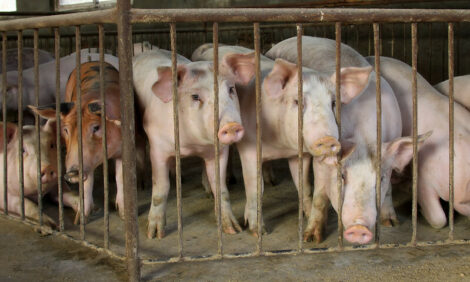



Proposed Changes to Canada’s Health of Animals Act Under Review
CANADA - Following what is described as an informal pre-consultation, a small number of changes, some significant, have been made to proposed amendments to Canada's Health of Animal’s Act.
<?=getCodeSnippet(45);?>
In summarizing the comments he says, “We had a lot of support for them [the changes]. But we also had a significant amount of concern expressed.”
He explains, “With respect to outcome based changes there were two areas that attracted a lot of attention and for which we did not get unanimous agreement and they are reducing the feed, water and rest intervals and prescribing loading densities.”
“For the most part the regulations are outcome based and most of our proposals are outcome based. However, there are a couple of areas where we have to be prescriptive, either because the outcome is predictably negative unless we provide a detailed recognition or because there’s a need to make it more clear.”
He notes those opposed felt that instead of setting or changing maximum limits for feed, water and rest, and instead of prescribing how many animals could fit in a certain space, regulations should focus on outcome and contain a statement saying that you must not over crowd.
“What some stakeholders would prefer is for us to take enforcement action if something happens to the animals as a result of over crowding or as a result of going to long without feed, water and rest.,” he says.
“With respect to loading densities, they would rather us not put loading densities into the regulations but would prefer that we reference the loading densities from the codes of practice, in particular the transport code.”
“For livestock that are not in the transport code, because there was no code for certain species like goats at the time that we made the transport code, we would use the specific species code. For example, the loading densities for goats would be taken from the goat code because goats are not mentioned in the transport code.”
“We brought that to our regulatory affairs and they said that they would do their best to have that proceed as recommended but they cautioned us that it may not be possible. Because, in regulation making, there is a rule that indicates that you can not reference an external document if that document is under the control of an organization that has a vested interest in the outcome.”
“We were deliberately broad in our description of what we were thinking of doing because we had not come to conclusions,” Dr. Doonan explains. “We wanted to find out what the stakeholders had to say and bring them in at an early stage and we also wanted to know what their reasoning would be for any changes so we provided a broad concept and asked them what they thought about it.”
Another common comment was related to the science of animal welfare. “They want to know, where is the Canadian science? So, instead of actually asking us to do anything in particular, a lot of the comments were asking, what is the science that is telling us there is a change needed?”
“As a civil servant I am in no position to predict what the timing would be or even if it will go through but I would say that, at this point, we couldn’t expect anything before the summer at the very earliest,” says Dr. Doonan. He notes it still has to go through the Canadian Food Inspection Agency which he expects will recommend acceptance then on to the department of justice and ultimately to the desk of the minister.
“We brought stakeholders in at a much earlier stage so there will be further opportunity for comment if this proposal is published in Canada Gazette 1. To that end we’re still recording any input that we receive and we still are receiving input.”
However he stresses, “We’re hoping that, as a result of the fact that we consulted widely already, that there will be a lot of support for the final version that we hope will be published in Canada Gazette 1.”
ThePigSite News Desk
In December 2005, the Canadian Food Inspection Agency (CFIA) served notice through its internet web site that it was considering updates to the Health of Animals Act and began informally gathering stakeholder input on proposed changes to portions of the Act that deal with transportation. Part 12 of the Health of Animals Regulation addresses the transportation of all livestock species into Canada, out of Canada, and within Canada by any mode of transport.
Informal Comment Period Concludes
“We have concluded what we're calling pre-consultations and we've made a few adjustments to our original proposal as a result of feedback,” says Dr. Gord Doonan CFIA senior staff veterinarian for the transportation of animals. “Those proposals are with our regulatory affairs people to put those changes into legal text.”Proposed Changes Generally Accepted
“For the most part, the vast majority of the concepts that we proposed for change were accepted by almost all of the respondents,” says Dr. Doonan.In summarizing the comments he says, “We had a lot of support for them [the changes]. But we also had a significant amount of concern expressed.”
Industry Seeks Outcome Based Regulations
“One of the things that the industry told us was they wanted any changes to be outcome based.”He explains, “With respect to outcome based changes there were two areas that attracted a lot of attention and for which we did not get unanimous agreement and they are reducing the feed, water and rest intervals and prescribing loading densities.”
“For the most part the regulations are outcome based and most of our proposals are outcome based. However, there are a couple of areas where we have to be prescriptive, either because the outcome is predictably negative unless we provide a detailed recognition or because there’s a need to make it more clear.”
He notes those opposed felt that instead of setting or changing maximum limits for feed, water and rest, and instead of prescribing how many animals could fit in a certain space, regulations should focus on outcome and contain a statement saying that you must not over crowd.
“What some stakeholders would prefer is for us to take enforcement action if something happens to the animals as a result of over crowding or as a result of going to long without feed, water and rest.,” he says.
CFIA Endorses Call for References to Codes of Practice
One of the frequent suggestions, which resulted in a key change to the original proposal, was that the regulation make reference to the codes of practice.“With respect to loading densities, they would rather us not put loading densities into the regulations but would prefer that we reference the loading densities from the codes of practice, in particular the transport code.”
“For livestock that are not in the transport code, because there was no code for certain species like goats at the time that we made the transport code, we would use the specific species code. For example, the loading densities for goats would be taken from the goat code because goats are not mentioned in the transport code.”
Reference to Codes of Practice Uncertain
Dr. Doonan says, “While stakeholders provided a good rationale for such a change and although CFIA is supporting the recommendation, it is still uncertain whether it can proceed.”“We brought that to our regulatory affairs and they said that they would do their best to have that proceed as recommended but they cautioned us that it may not be possible. Because, in regulation making, there is a rule that indicates that you can not reference an external document if that document is under the control of an organization that has a vested interest in the outcome.”
Stakeholders Call for More Detail and Question Science Used
Several stakeholders indicated they would have liked more detail on the web site document.“We were deliberately broad in our description of what we were thinking of doing because we had not come to conclusions,” Dr. Doonan explains. “We wanted to find out what the stakeholders had to say and bring them in at an early stage and we also wanted to know what their reasoning would be for any changes so we provided a broad concept and asked them what they thought about it.”
Another common comment was related to the science of animal welfare. “They want to know, where is the Canadian science? So, instead of actually asking us to do anything in particular, a lot of the comments were asking, what is the science that is telling us there is a change needed?”
Next Step Canada Gazette 1
Once review of the revised document has been completed, it may or may not be published in Canada Gazette 1.“As a civil servant I am in no position to predict what the timing would be or even if it will go through but I would say that, at this point, we couldn’t expect anything before the summer at the very earliest,” says Dr. Doonan. He notes it still has to go through the Canadian Food Inspection Agency which he expects will recommend acceptance then on to the department of justice and ultimately to the desk of the minister.
Comments Still Being Accepted
As well he notes, “We are still receiving comments even though our pre-consultations are over. And we are recording all of the comments that we receive because the pre-consultations were an extra step.”“We brought stakeholders in at a much earlier stage so there will be further opportunity for comment if this proposal is published in Canada Gazette 1. To that end we’re still recording any input that we receive and we still are receiving input.”
However he stresses, “We’re hoping that, as a result of the fact that we consulted widely already, that there will be a lot of support for the final version that we hope will be published in Canada Gazette 1.”
ThePigSite News Desk






